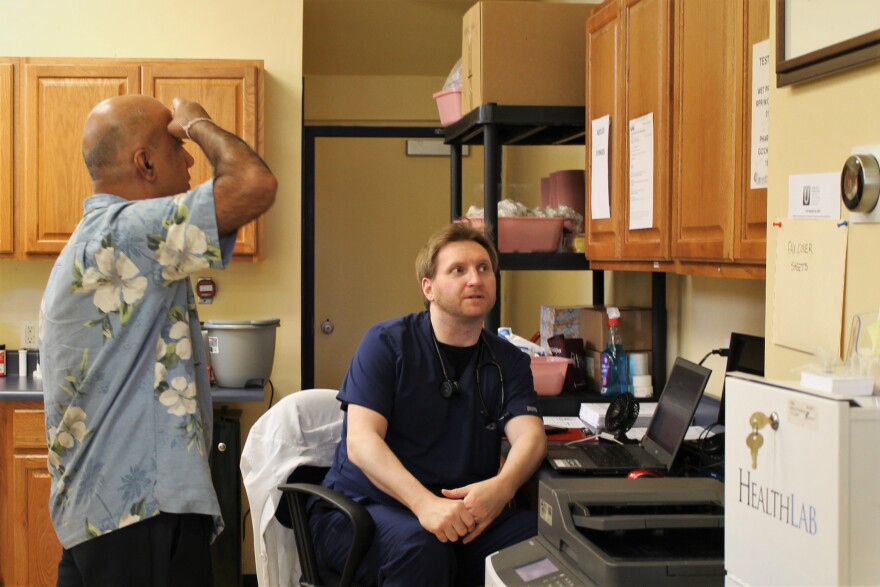One of the only urgent-care centers on St. Louis’ medically underserved north side is in danger of closing if it doesn’t receive more patients.
North City Urgent Care opened five years ago near North Skinker Parkway and Dr. Martin Luther King Drive. Since then, the center hasn’t posted a profit, owner Sonny Saggar said.
Although there are only two urgent-care clinics in north St. Louis, patient volume is low, Saggar said. On a typical day, there is only a handful of patients — far fewer than the 25 patients a day needed to turn a profit, he said.
“It’s a double-edged sword to have no competition on the north side but also limited awareness,” Saggar said. “I don’t think it’s because there’s not enough people; I think it’s because they’re not aware.”
Urgent-care clinics provide immediate walk-in medical care for ailments such as sprained ankles, infections or viruses. The clinics aim to reduce use unnecessary use of expensive emergency rooms.
Urgent-care clinics are businesses that seek profits. Unlike other clinics, they don’t receive grants or federal assistance. That means they go where they make money, most often in more affluent areas. Saggar operates two other urgent-care clinics in Creve Coeur and downtown St. Louis that support the north side location.
“I suspect the majority of urgent cares will open with the same kind of thinking as why most ice-cream shops would open … the area that is the most profitable,” Saggar said.
The number of urgent-care clinics has been growing in the south and west parts of the St. Louis area but not to the north. The St. Louis-based company Total Access Urgent Care operates 18 locations around the region and has nine more in different stages of development. But none are in north St. Louis, CEO Matt Bruckel said.
Population density and potential customers are the first thing the company looks for when opening a location, Bruckel said.
“Growth and development is extremely expensive. The average site that we develop is several millions of dollars of funds in order to buy the ground, build the building and open for business,” he said.
Bruckel said he’s always looking for the right location to serve people in north St. Louis, but hasn’t found anything yet.
“We do have to make a profit to pay our employees and keep our doors open, and these are real dollars we’re talking about,” he said.

Experts say placing a clinic in an underserved area isn’t enough to attract patients. Patients need to trust they’ll receive the same quality care as they would in an emergency room, said Will Ross, Washington University Associate dean and Medical School professor.
Ross doesn’t think the problem for North City Urgent Care is that people aren’t aware of its services. Instead, he said, area residents may not feel comfortable going there.
To attract patients, urgent-care clinics need to build trust with people and help them be at ease with clinics and their serviess, Ross said.
Comfort, trust and familiarity are important when it comes to attracting patients, he said.
“That’s going to be particularly true among populations that have been historically denied access to care or who have distrust of the health-care system,” Ross said, adding that for many people, the emergency room is a known quantity.
“Patients will make what to them is a logical decision to access care at an E.R.,” he said. “They’ll feel that care is comprehensive, they’ll get the results back; For the most part, they won’t have to worry about paying a bill.”
Ross warns against the stereotype that all low-income people and uninsured people use the emergency room for primary care in place of lower-cost clinics. And a recent HealthAffairs study found uninsured people don’t use the emergency room more — they use other types of care less.
But data from the Bi-State Development Research Institute found emergency-department use was much higher for people who live in north St. Louis compared with other parts of the city. From 2010 to 2013, more than 700 people per every 1,000 visited the emergency room, compared with fewer than 370 per every 1,000 residents in the south and west suburbs.
Ross thinks placing urgent-care centers close to existing federally qualified health centers and hospitals that are already well-used by patients could help attract more patients – and ultimately more clinics – to the north St. Louis.
Follow Sarah on Twitter: @Petit_Smudge
Correction: Total Access Urgent Care has 18 St. Louis-area locations. A previous St. Louis Public Radio report misstated the number of locations.






